Click Below For Chinese Version
点击下方链接跳转中文文章
For any object whatsoever, in fact, the reality principle may be put in brackets. No sooner does an object lost its concrete practical aspect than it is transferred to the realm of mental practices. In short, behind every real object there is a dream object. [1]
—Jean Baudrillard, The System of Objects
“Objects” here do not just refer to physical objects, they are also indicative, that is, their symbolic features have more strength hidden behind them. So, what are the objects from “Objects of Idea” in this exhibition? What does “Idea” mean? The first instinct from most visitors is that their attention has been attracted by this subject, which is similar to the “translation of a name.” The word “Idea” sounds grounded, especially when I found that it was inspired by the English theme “Objects of Idea” and it suddenly dawned on me, and then simple phrases were engraved into my mind. It formed an ingenious transformation of the cultural relationship between the two words respectively in Chinese and English. From the theme, we can detect the ingenious setting of idea by the artist in this exhibition, and it also brings forward “a recognition” from the very beginning.
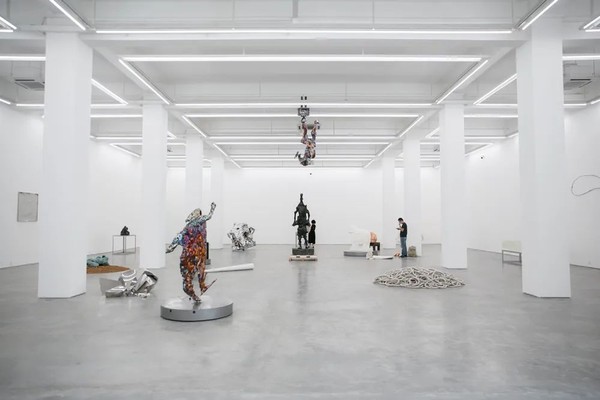
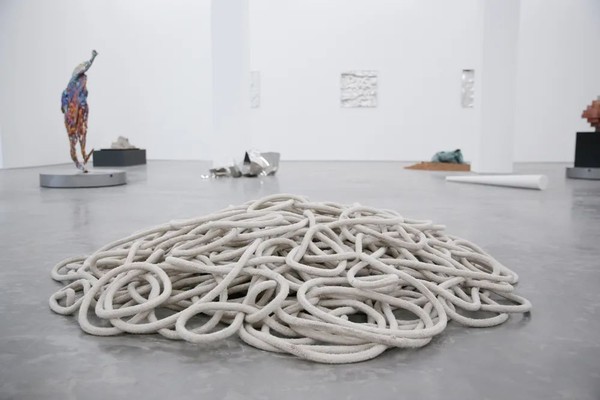
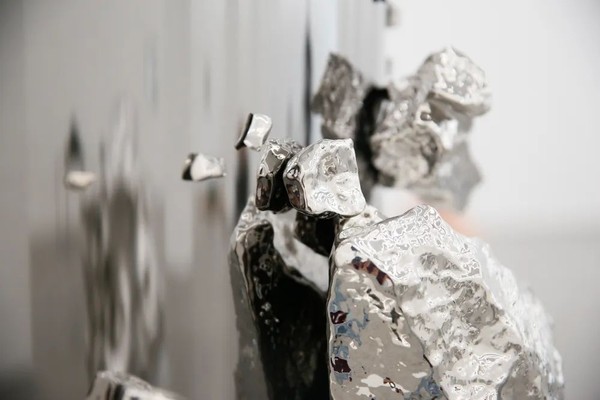
Exhibition View of “Objects of Idea”
“Concept and production” are two important propositions that run through his creations. What kind of connection exists between the concept and production of “objects”? How does the “anti-ready-made” methodology described by the artist retain the authenticity of creation? In an exclusive interview with CAFA ART INFO, Zhan Wang confided that he paid great attention to the experience brought by life experience and feelings. His creation emphasizes the insights derived from his practical experience and production process. Then, how does “Objects of Idea” integrate idea with action (experiment)?
the Origin of Conceptual “Objects”
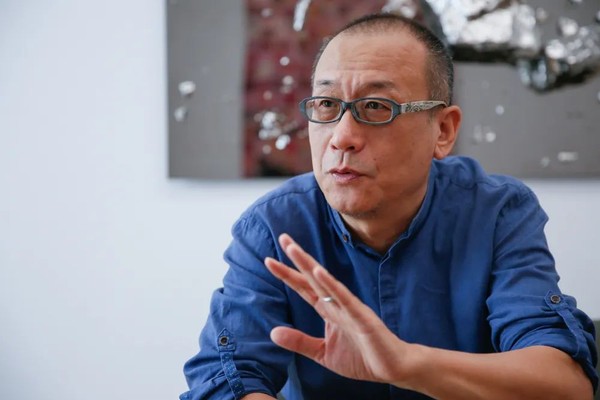
An Interview with Zhan Wang by CAFA ART INFO in Long March Space
“Idea” freely roams between the meaning boundaries of words such as “thinking”, “thought”, “concept” and even “opinion”, representing the arrival of inspiration, the emergence of thinking and thinking of individual artists. In this interview, the artist further explained his thinking about idea, “The meaning of concept is too grand, and it is closer to the big concept of conceptual art. The original meaning of idea in English is relatively broad, but it is easy to misunderstand and limit its difference in the Chinese translation. The title of ‘Boundaries among Objects’ is too big. It is not easy to reconcile the subject name of the specific work. At this stage, ‘Objects of Idea’ appropriately summarized the significance of these 23 exhibits.”
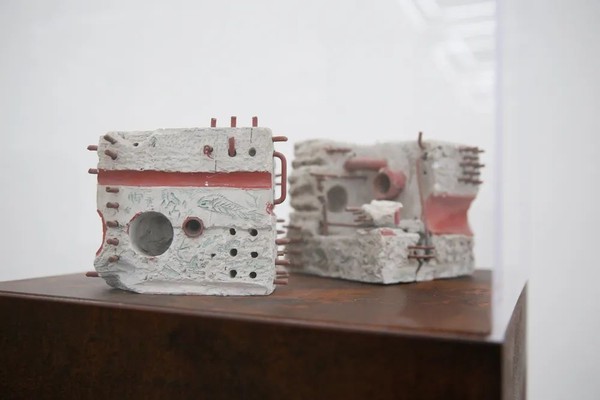
“Underground”, 1990, Clay, iron wire, Including 2 sculptures and 1 display stand, 43x43x144cm
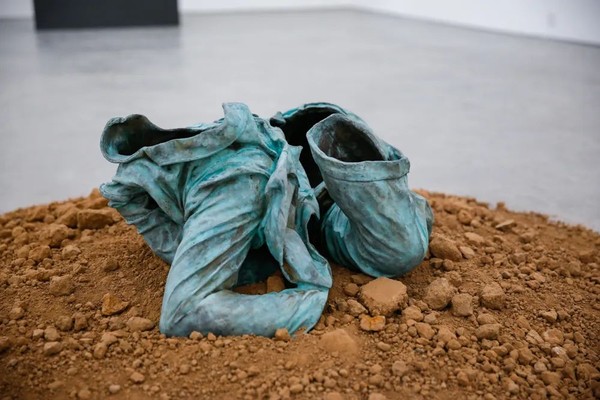
“Shell of Mao Suit No. 1”, 1994, Bronze, soil, 80x72x39cm
Zhan Wang was born in Beijing, China in 1962. He graduated from the Sculpture Department of China Central Academy of Fine Arts in Beijing in 1996. He has been teaching in the Sculpture Department of the Central Academy of Fine Arts. He is also one of the earliest Chinese sculptors to have been noticed by the international art community. He has always had exuberant energy for artistic practices since the 1990s.
Zhan Wang recalled that, in 1993 he began to experiment with an empty shell sculpture, trying to peel off the “physical body” in the shell. Therefore, what kind of “clothing” appearance he chose to wrap the “hollow” showed the meaning of the symbol—the “Mao Suit” that integrates political symbols, cultural characteristics, modes of thinking, and common memories—becomes the beginning of his thinking about social phenomena through artistic creation, and then “body, hollowness, boundary, contradiction, memory…”and other personal perceptions and experience of the artist was retained and gradually melted into the subsequent scripts for creation. Although different forms were derived, the key elements such as “shell”, “flesh” and “heart” can almost always be found as clues in his subsequent works. The “objects” become the externalization result of the artist’s “idea.”
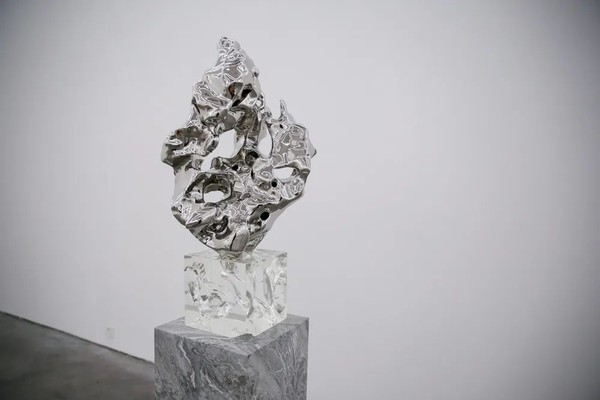
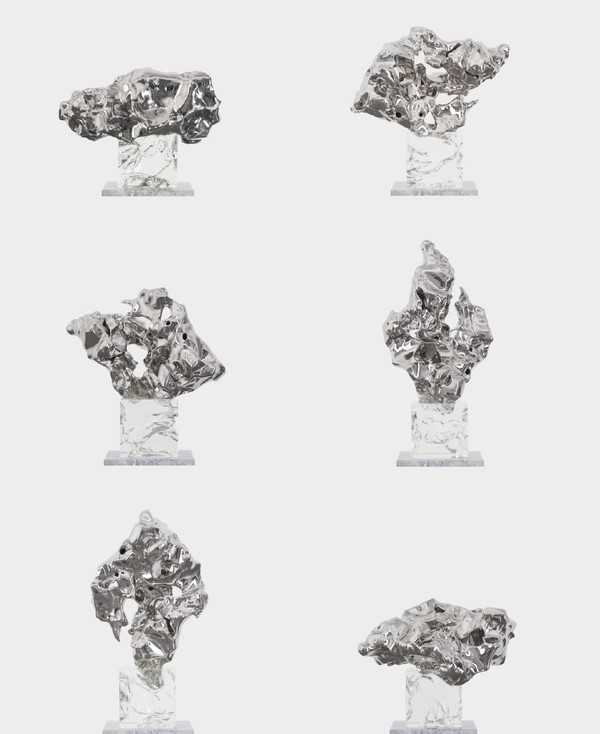
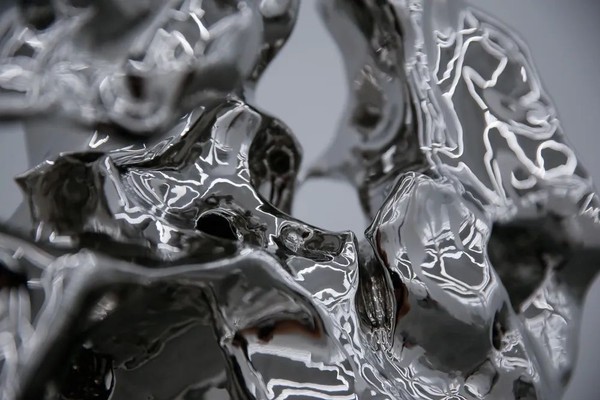
“Six-Sided Artificial Rock”, 2013-2019
“If the previous ‘Mao Suit’ series of works reflected his thinking from the perspective of art intervention in society, then the ‘Artificial Rock’ series embodies the relationship between me and culture.”[2] In the late 1990s, China underwent rapid development in urbanization, business and economy all of which have changed rapidly, and living standards have been gradually improved, but the development of culture has failed to keep up. From the level of cultural “confidence” that is still being sought today, one can also realize that the uneven and dislocated developments between “economy and culture.”
The use of stainless steel to create the artificial rock, for Zhan Wang, “It is like condensing the complex issues of this era into a symbol, but also a way of commemoration.”[3] The whole body of artificial rock exudes the luster of stainless steel, carrying a strong metaphor, “Fake is also true and when true is also false”? The debate on the authenticity of mountain rocks reflects the bizarre phenomenon of the changing times. The splendid and gorgeous appearance forms a strong contrast with the seemingly “fancy” core—when he started to copy natural rockery with stainless steel, it was this kind of "contemporary" visual characteristics of the material and the symbolic meaning of interaction with the environment that attracted him. It looks like a precious metal but actually uses a cheap industrial material—its “bright and flashy” and “multiple” effect (commented by Zhan Wang) was very popular in a dream that was both grandiose and practical at that time. [4]
The series of stainless steel skins exhibited this time has continued this art language into expression. “Imprinting Terrain” (2015) originated from the artist's moving of his studio when he “spiked” the only ground that could not be taken away, and it became a framed “painting on an easel.” The price of the square-meter work jokingly corresponds to the housing prices in Beijing. This material recapitulates the “exaggerated and practical” dreams of the 1990s and it does not seem to be out of date in the new era of the 21st century? The small-size “Six-Sided Artificial Rock” (2013-2019) shows the idea that “there is no concept of pros and cons when looking at a stone from the universe” through the multidimensional joining model of sculpture and base; “Asymmetric Artificial Rock” (2017) follows the natural principle that no stone is a repetitive theorem in the world. Two identical rubbed stones are connected in reverse to form a non-mirrored relationship, which further elaborates the artificial concept of “false.”
“Stainless Artificial Rock” has always been a representative series by Zhan Wang known by the public. He has not concealed the sharing of the sculpture creation craftsmanship and he is willing to reveal the “secret production” rules to many artists. The creative process of “artificial rock” is to splice small pieces. Small works will use about 20-30 pieces and large works have hundreds of pieces. After splicing, they are repeatedly polished using coarse sandpaper and fine sandpaper, turning over the “small pieces” from the high points of the stone and it includes the process of measuring “natural objects” in an artificial way, from conception, production to real objects, it constitutes a dialogue between the artist and the “stone objects,” and another dialogue between the “stainless steel objects” and the audience.
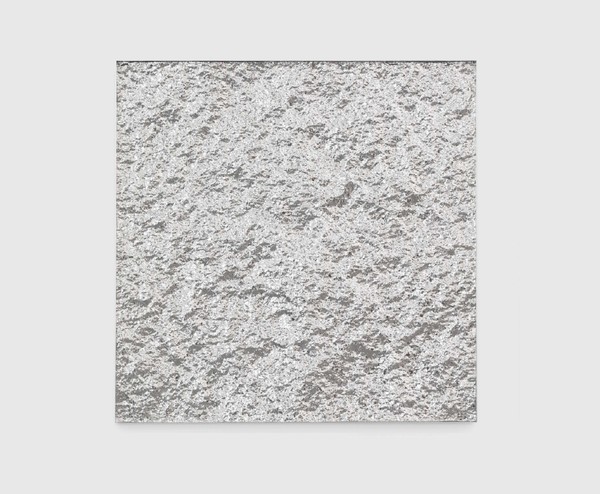
“Imprinting Terrain No. 27”, 2015, Stainless steel, 100x100cm
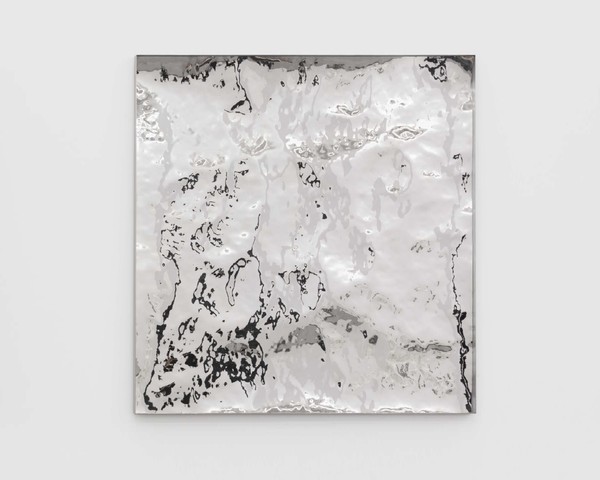
“Imprinting Terrain No. 25”, 2015, Stainless steel, 100x100cm
He specifically applied for a patent for the “method of making stones from stainless steel plates,” “The originality of art is actually difficult to prove. Can the method of applying for technical patents indirectly prove the originality of art?” It is not difficult to find that, this is not only an emphasis on artistic production techniques, but it also puts forward an important requirement for the driving force to ensure originality in artistic experiments. The appeal for “originality” is the core energy that an artist can get established for a long time.
The Tangible and Intangible:
Concealed Rock, Forms in Flux, Morph and Fractal Structure
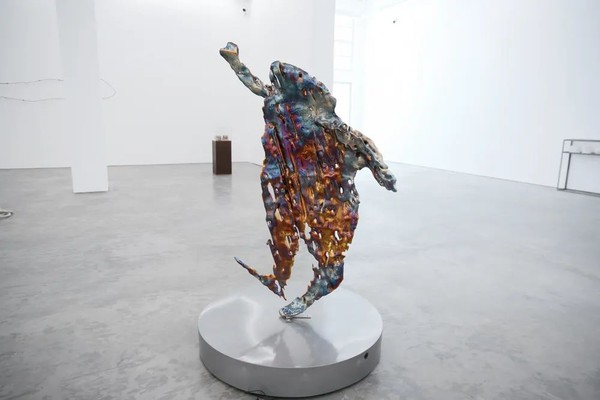
“Forms in Flux No. 14”, 2017, Stainless steel, 110x22x170cm
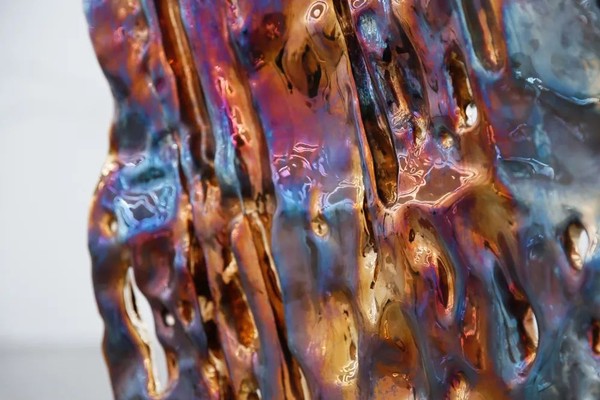
“Forms in Flux No. 14”(detail), 2017, Stainless steel, 110x22x170cm
It should be pointed out that the “objects” generated from idea can be a substance, material, entity, but also images, records, behaviors, events, experiments, etc. “Objects” have boundaries. Boundaries mean measurement, balance, comparison and distinction. It also includes conceptual contrasts such as speciousness, tangible and intangible, and visible and invisible. For example, in the “Morph” (2010-2014) series, Zhan Wang has made the opposite interpretation of the “shape of the object” in the six laws of Sheikh in Southern Qi, intercepting the image of the human body reflected on the surface of stainless steel, and he specially uses a skin-like texture to deal with the original, and the original way “from object to form” becomes tangible (non-existent) afterwards. Within this is the rhetorical question and reconstruction of Chinese cultural artifacts, as well as the processing rules from virtual “image” to the physical conversion that brings out the artist's strong personal style.
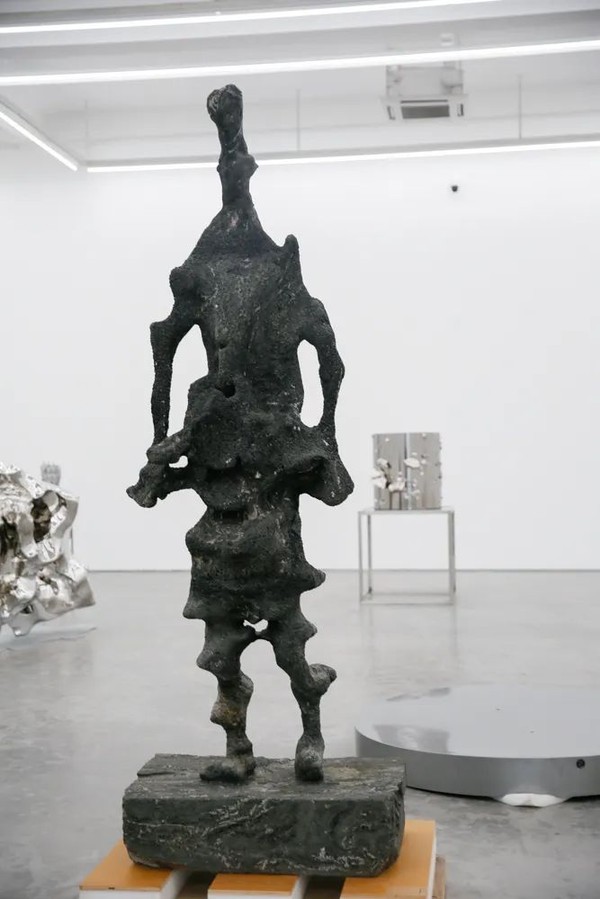
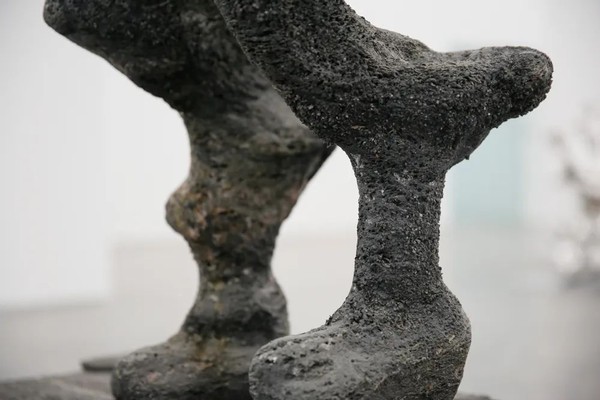
“Forms in Flux No. 6”, 2018, Volcanized rock, 88x52x250cm
“Taboo” (2007-2019) is derived from a baby image which has marked the mosaic in the news. The three-dimensional mosaic is a rhetorical question about the image, and it also reminds people of the existence of “taboo”; “Dual System” (2009) Is a “great work” that might be easily overlooked by the audience, and those with common academic experience may be fascinated by the critical spirit of the work. Originally, the artist did not treat this as a work, but placed them in the studio and they always remind the artist of the two “contrasting” symbols for thinking about the artist’s mind—the normal cylinder, sphere, cube, etc. on the left symbolize Western rational philosophy, and the slant volume blown by the wind on the right, might feel like flowing after a long observation, with a more Eastern artistic spirit. It is “metaphysical and ideological.” The “material” of the work is surprisingly simple, with a few simple geometric bodies, but the more simple things condense, the more powerful the conceptual criticism is.
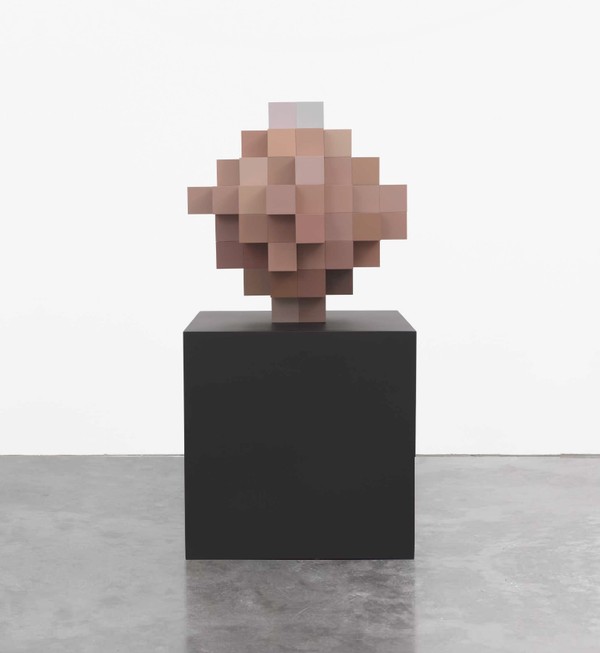
“Taboo”, 2007-2019, Acrylonitrile-butdiene-styrene board, spray paint, 60x60x60cm
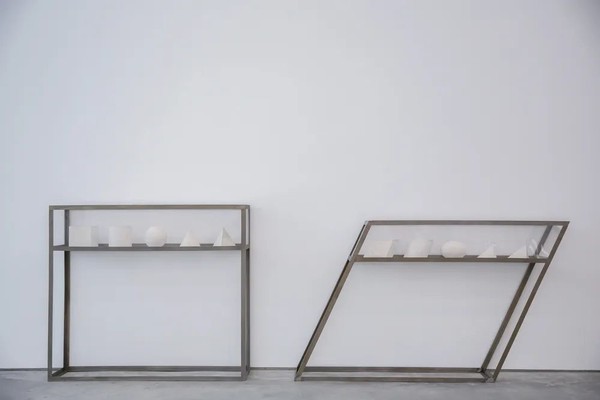
“Dual System”, 2009, White marble, stainless frame, PMMA, Dimension variable
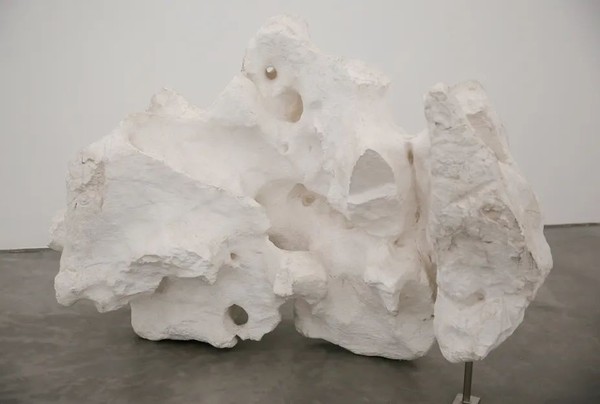
“Plaster Model”, 2015, Unique, Plaster, 193x107x130cm With metal brace
Similarly, another piece of “Plaster Model” also uses natural rockery as a teaching aid. The plaster model serves as a hypothetical model for studying the world and it also serves as a carrier for people to observe and imagine the world. The plaster statue of the rockery is also a series of creations in the college constructing rhetorical questions about “David”, “head sculptures” and so on. These works are, on the one hand, rethinking the absolute standards and truths of “academics”, “rationality” and “model” that people have long held and on the other hand, they are also personal thinking and artistic experimental creations on the methodology of understanding the essence of the world.
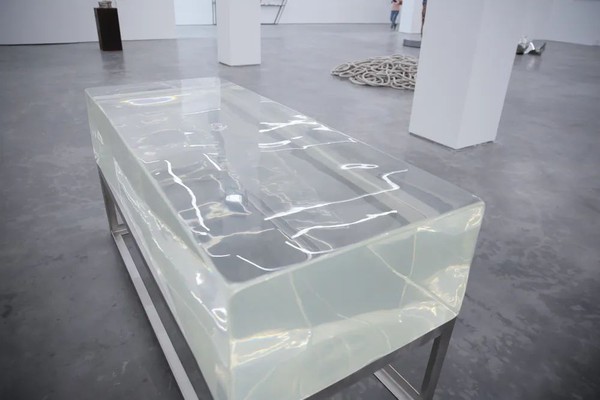
“Concealed Rock No. 2”, 2012, Acrylic resin, 180x73x38.5cm Exhibition View
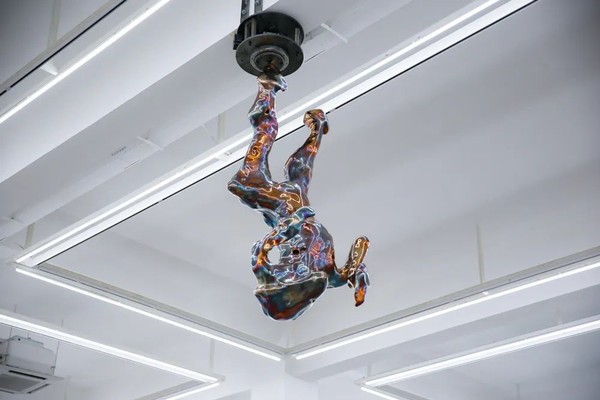
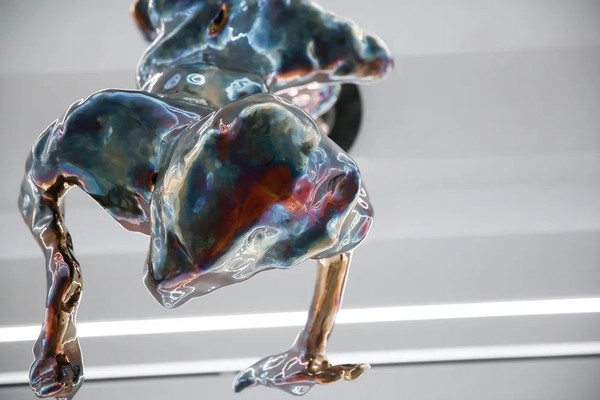
“Forms in Flux No. 14”, 2017, Stainless steel, 110x22x170cm
As the name suggests, “Concealed Rock” (2012) looks like a large piece of transparent material with all the details omitted, but in reality it is “transparent wrapped and transparent.” The artist rebuilt a rock with transparent material and then injected the same material after polishing it. In the transparent material, theoretically the original image of the rock should disappear, but due to the hand-made traces, the hidden edges of the rock are faintly visible under the light, looming and seemingly absent. “Forms in Flux” is based on the mathematical algorithm of Fluid Mechanics to simulate the abnormal changes of people after entering the magma. With randomly generated “characters,” the surface is heated to a high temperature and it emits “tragic splendor,” formulaic procedures and random generation, indefinite shapes and fired material, all antagonistic relationships will lead to different results. The artist and the audience have a completely open discussion about uncertainty.
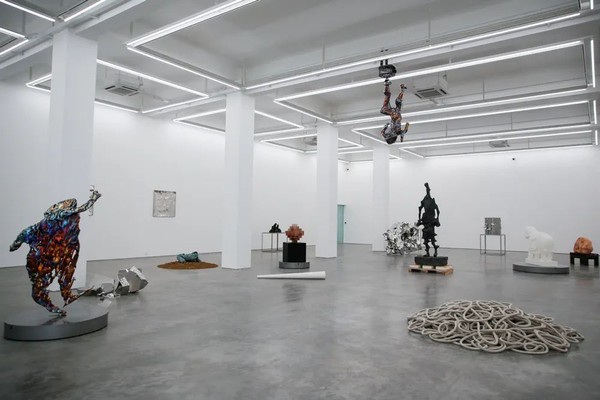
Exhibition View
Chaos and Order:
Universe, Floating Island of Immortals and Eternal life
Infinite and finite, single and plural, reality and illusion. All of Zhan Wang’s works show profound oriental mysticism. Because of the sudden “mind” that uses various materials and techniques to form “objects,” the long-term exploration and dialectical research on the boundaries of objects, the exploration in the space of objects and the vast universe are clues to his works. In 2010, Zhan Wang began to create the “Universe Series,” and successively created works such as “My Universe”(2010), “Small Universe” (2012), “Universe in the Curved Space” and other works, re-deconstructing the “scientific” universe in an artistic way. Fragments, space, gathering, divergence, and twinkling, leave people with endless space for the imagination of the universe; a bronze sculpture of “Small Floating Island of Immortals” was placed on the temple of worship with burning incense by the artist. From 2013 to 2019, over these six years, the copper surface was gradually blackened, and the real worship environment becomes the natural colorant of the sculpture material. Surrounded by the energy field of faith, the sculpture itself is given the meaning of a “religious” sacred instrument.
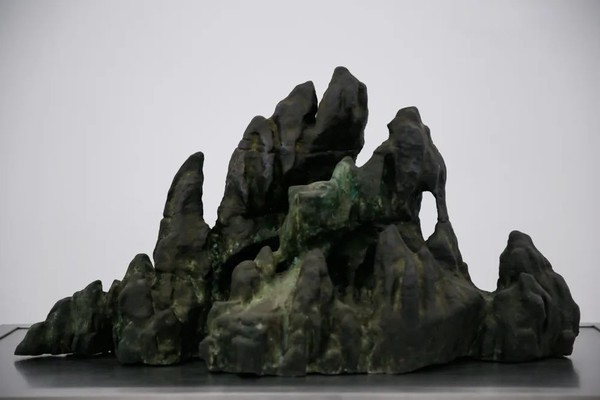
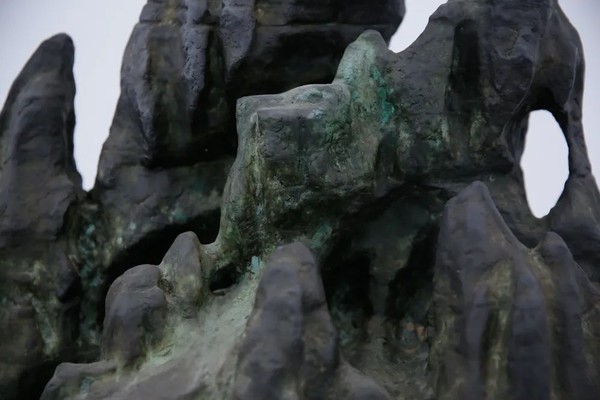
“Small Floating Island of Immortals”, 2013-2019, Unique, Bronze, colored with burning incense, 90x45x55cm
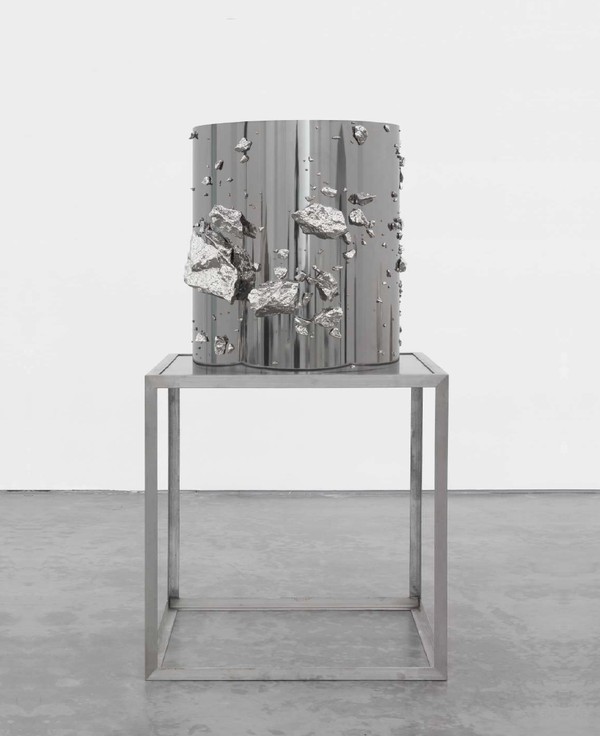
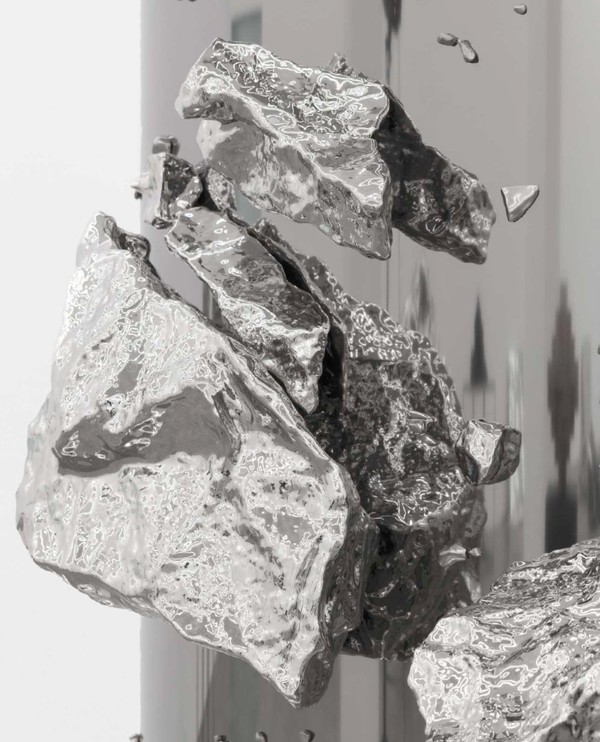
“Universe in the Curved Space”, 2019, Black titanium stainless steel plate, stainless steel, 80x76x89cm
Another piece of “An Eternal Light Beam” (2013-2019) is related to “Form of the Formless”(2012) in the dark space. When the artist makes the phantom “light” into a physical “object,” what kind of effect does it produce? The tangible, long chalk-like “beam of light” is questioning and challenging the unyielding “visual light,” "You think you can't see it, but you are in it.” What you can see might not be where you can stay.
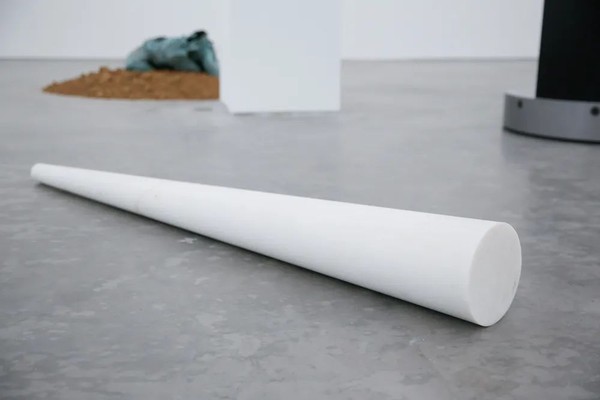
“An Eternal Light Beam”, 2013-2019, White marble, 76x20x6cm
The material of “Mobius Ring” is special. It is taken from the fragments of the Chang’e-3 rocket. The artist welded the original tubular material of the wreckage, leaving the burning dents of technological “object” in recesses. “I think it is also the closest distance to the original with high-tech. It’s like a curved space, the farther the two ends are, the closer it is,” Zhan Wang also described in the interview with CAFA ART INFO, what surprised him in the production process of the work. “Under this premise, I made creation rules for myself: respect the materials, look for the inter-material relationship between them and avoid imposing any pre-conceived ideas.” Some fragments are very independent, so be independent and connect them as if transparency should be, but the lack of order of the ring-shaped pipe unexpectedly connected into the head and tail by itself creating an accidental production. It seems that there is a sign in it, so wonderful.
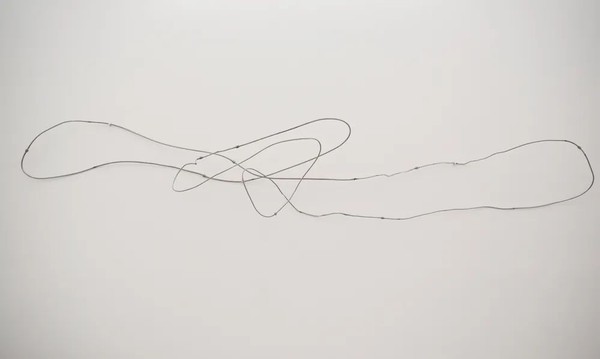
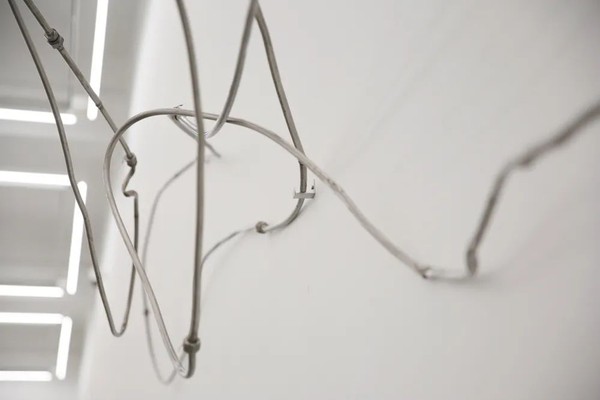
“Mobius Ring”, 2019, fragments of the Chang’e-3 rocket
For Zhan Wang, materials, techniques, science and technology, and algorithms are closely centered on the artistic practice and unification under the guidance of “idea.” More importantly, the entire manufacturing process including mold reversal, welding, and polishing are also parts of “creation.” They are finally condensed on the “objects,” and the audience may only see the last physical “object,” but it is much more than that.
I remembered that Baudrillard mentioned in Object System, “At all events, whatever the functioning of the object may be like, we invariably experience it as OUR functioning: whatever the object’s efficient mode—even should it be absurd, as in the case of the ‘gizmo’—we project ourselves into the efficiency. In fact we do so especially when it is absurd, as witness the old phrase, at once magical and comical, according to which a thing ‘might always come in useful’: while it is true that objects do indeed serve specific purposes at times, they are much more commonly good for everything and nothing, and in that case their true utility lies in the very fact that they ‘might always come in useful’” [5] Being different from the consumption of daily products while excluding the market value of “artworks”, the enlightening, thinking and conceptual nature of art objects opens up a clue to the story. Ideas come first, and when placed in the context of art, they can arouse people’s speculation, but they might be the maximum utility of the “useless use of art.”
Text by Zhang Yizhi
Translated and edited by Sue/CAFA ART INFO
Work Image Courtesy of the Artist and Long March Space
Photos of Exhibition View by Hu Sichen/CAFA ART INFO
References:
Exhibition Manual of “Objects of Idea: Zhan Wang Solo Exhibition";
Interview with artist Zhan Wang from CAFA ART INFO, July 24, 2020 in the Long March Space.
[1] and [5] Jean Baudrillard, Translated by James Benedict,The System of Objects (London: VERSO, 1996), 117-118.
[2] [3] Lu Zhengyuan, “An Interview with Zhan Wang: Personal Awakening in the New Era,”Art Observation (2018,12), 13-15.
[4] Wu Hung, Foreword to The New Suyuan Stone Catalogue, by Zhan Wang(Beijing: SDX Joint Publishing Company, May 2008), 8.
Copyright Reserved 2000-2024 雅昌艺术网 版权所有
增值电信业务经营许可证(粤)B2-20030053广播电视制作经营许可证(粤)字第717号企业法人营业执照
 京公网安备 11011302000792号粤ICP备17056390号-4信息网络传播视听节目许可证1909402号互联网域名注册证书中国互联网举报中心
京公网安备 11011302000792号粤ICP备17056390号-4信息网络传播视听节目许可证1909402号互联网域名注册证书中国互联网举报中心
网络文化经营许可证粤网文[2018]3670-1221号网络出版服务许可证(总)网出证(粤)字第021号出版物经营许可证可信网站验证服务证书2012040503023850号